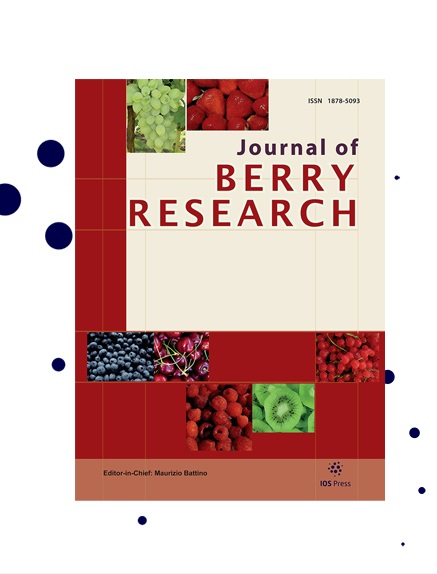An HD-Zip transcription factor, VvHDZ4, in grapes (Vitis vinifera L.) confers enhanced drought tolerance in transgenic tomato
IF 1.4
4区 农林科学
Q3 PLANT SCIENCES
引用次数: 1
Abstract
BACKGROUND: HD-Zip genes encode several large and highly conserved protein families of transcription factors that play important roles in plant development and responses to environmental stress. To date, information about the involvement of HD-Zip in grape to drought response is limited. OBJECTIVE: The production of grapes is limited by a range of biotic and abiotic stresses, which cause significant losses in yield every year as well as a reduction in fruit quality. Identification and analysis of stress related genes in grapes are very important for cultivating more robust varieties with environmental stress resistance METHODS: We isolated a homeodomain-leucine zipper gene (HD-Zip), VvHDZ4, from grape, Vitis vinifera L. “Yatomi Rose”, and characterized VvHDZ4 based on analyses of its expression patterns, subcellular localization, transcription activity, and overexpression. RESULTS: We found that VvHDZ4 was highly expressed in roots and leaves, localized to nucleus, and activated the expression of reporter genes in yeast. The overexpression (OE) of VvHDZ4 led to enhanced drought stress tolerance in Solanum lycopersicum L. “Ailsa Craig” (tomato). The drought-tolerant phenotypes of the OE lines exhibited decreases in electrolyte leakage and rate of water loss, higher photosynthetic production and net photosynthesis rate, and showed up-regulation of superoxide dismutase (SOD), catalase (CAT), peroxidase (POD), and ascorbate peroxidase (APX), all of which are key antioxidant enzymes known to be activated during drought stress. Moreover, we observed the up-regulation of four additional drought stress indicator genes, SIDREB2A, SIAREB, SIRD29 and SIERD10, in the OE lines. VvHDZ4 improved drought tolerance in tomato, and the modes of action possibly consist of reducing membrane damage, increasing photosynthetic productivity, and modulating the expression of stress defense genes. CONCLUSIONS: This work increases our understanding of the important roles HD-Zip transcription factors in the responses of plants to the environment, especially abiotic stress.葡萄(Vitis vinifera L.)中的HD-Zip转录因子VvHDZ4使转基因番茄的抗旱性增强
背景:HD-Zip基因编码了几个在植物发育和环境胁迫反应中起重要作用的高度保守的转录因子蛋白家族。迄今为止,有关HD-Zip参与葡萄干旱反应的信息是有限的。目的:葡萄的生产受到一系列生物和非生物胁迫的限制,这些胁迫导致每年产量的重大损失以及果实质量的降低。方法:从葡萄品种Vitis vinifera L.“Yatomi Rose”中分离出同源域亮氨酸拉链基因(HD-Zip) VvHDZ4,并对其表达模式、亚细胞定位、转录活性和过表达进行了分析。结果:我们发现VvHDZ4在酵母根和叶中高表达,定位于细胞核,激活了报告基因的表达。VvHDZ4基因的过表达导致番茄(Solanum lycopersicum L. " Ailsa Craig ")耐旱性增强。OE株系的耐旱表型表现为电解质泄漏和水分流失率降低,光合产量和净光合速率提高,超氧化物歧化酶(SOD)、过氧化氢酶(CAT)、过氧化物酶(POD)和抗坏血酸过氧化物酶(APX)水平上调,这些酶都是已知在干旱胁迫下激活的关键抗氧化酶。此外,我们还观察到4个额外的干旱胁迫指示基因SIDREB2A、SIAREB、SIRD29和SIERD10在OE品系中的表达上调。vhdz4提高番茄抗旱性,其作用机制可能包括减少膜损伤、提高光合生产力和调节胁迫防御基因的表达。结论:本研究增加了我们对HD-Zip转录因子在植物对环境,特别是非生物胁迫反应中的重要作用的认识。
本文章由计算机程序翻译,如有差异,请以英文原文为准。
求助全文
约1分钟内获得全文
求助全文
来源期刊

Journal of Berry Research
Biochemistry, Genetics and Molecular Biology-Biochemistry
CiteScore
3.50
自引率
11.80%
发文量
21
期刊介绍:
The main objective of the Journal of Berry Research is to improve the knowledge about quality and production of berries to benefit health of the consumers and maintain profitable production using sustainable systems. The objective will be achieved by focusing on four main areas of research and development:
From genetics to variety evaluation
Nursery production systems and plant quality control
Plant physiology, biochemistry and molecular biology, as well as cultural management
Health for the consumer: components and factors affecting berries'' nutritional value
Specifically, the journal will cover berries (strawberry, raspberry, blackberry, blueberry, cranberry currants, etc.), as well as grapes and small soft fruit in general (e.g., kiwi fruit). It will publish research results covering all areas of plant breeding, including plant genetics, genomics, functional genomics, proteomics and metabolomics, plant physiology, plant pathology and plant development, as well as results dealing with the chemistry and biochemistry of bioactive compounds contained in such fruits and their possible role in human health. Contributions detailing possible pharmacological, medical or therapeutic use or dietary significance will be welcomed in addition to studies regarding biosafety issues of genetically modified plants.
 求助内容:
求助内容: 应助结果提醒方式:
应助结果提醒方式:


